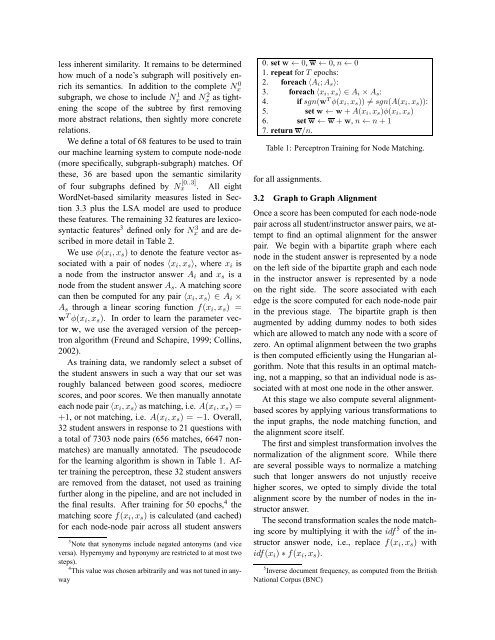Learning to grade short answer questions using semantic similarity ...
Learning to grade short answer questions using semantic similarity ...
Learning to grade short answer questions using semantic similarity ...
Create successful ePaper yourself
Turn your PDF publications into a flip-book with our unique Google optimized e-Paper software.
less inherent <strong>similarity</strong>. It remains <strong>to</strong> be determined<br />
how much of a node’s subgraph will positively enrich<br />
its <strong>semantic</strong>s. In addition <strong>to</strong> the complete Nx<br />
0<br />
subgraph, we chose <strong>to</strong> include Nx 1 and N2 x as tightening<br />
the scope of the subtree by first removing<br />
more abstract relations, then sightly more concrete<br />
relations.<br />
We define a <strong>to</strong>tal of 68 features <strong>to</strong> be used <strong>to</strong> train<br />
our machine learning system <strong>to</strong> compute node-node<br />
(more specifically, subgraph-subgraph) matches. Of<br />
these, 36 are based upon the <strong>semantic</strong> <strong>similarity</strong><br />
of four subgraphs defined by N [0..3]<br />
x . All eight<br />
WordNet-based <strong>similarity</strong> measures listed in Section<br />
3.3 plus the LSA model are used <strong>to</strong> produce<br />
these features. The remaining 32 features are lexicosyntactic<br />
features 3 defined only for N 3 x and are described<br />
in more detail in Table 2.<br />
We use φ(x i ,x s ) <strong>to</strong> denote the feature vec<strong>to</strong>r associated<br />
with a pair of nodes 〈x i ,x s 〉, where x i is<br />
a node from the instruc<strong>to</strong>r <strong>answer</strong> A i and x s is a<br />
node from the student <strong>answer</strong> A s . A matching score<br />
can then be computed for any pair 〈x i ,x s 〉 ∈ A i ×<br />
A s through a linear scoring function f(x i ,x s ) =<br />
w T φ(x i ,x s ). In order <strong>to</strong> learn the parameter vec<strong>to</strong>r<br />
w, we use the averaged version of the perceptron<br />
algorithm (Freund and Schapire, 1999; Collins,<br />
2002).<br />
As training data, we randomly select a subset of<br />
the student <strong>answer</strong>s in such a way that our set was<br />
roughly balanced between good scores, mediocre<br />
scores, and poor scores. We then manually annotate<br />
each node pair〈x i ,x s 〉 as matching, i.e. A(x i ,x s ) =<br />
+1, or not matching, i.e. A(x i ,x s ) = −1. Overall,<br />
32 student <strong>answer</strong>s in response <strong>to</strong> 21 <strong>questions</strong> with<br />
a <strong>to</strong>tal of 7303 node pairs (656 matches, 6647 nonmatches)<br />
are manually annotated. The pseudocode<br />
for the learning algorithm is shown in Table 1. After<br />
training the perceptron, these 32 student <strong>answer</strong>s<br />
are removed from the dataset, not used as training<br />
further along in the pipeline, and are not included in<br />
the final results. After training for 50 epochs, 4 the<br />
matching score f(x i ,x s ) is calculated (and cached)<br />
for each node-node pair across all student <strong>answer</strong>s<br />
3 Note that synonyms include negated an<strong>to</strong>nyms (and vice<br />
versa). Hypernymy and hyponymy are restricted <strong>to</strong> at most two<br />
steps).<br />
4 This value was chosen arbitrarily and was not tuned in anyway<br />
0. setw ← 0,w ← 0,n ← 0<br />
1. repeat forT epochs:<br />
2. foreach〈A i ;A s 〉:<br />
3. foreach〈x i ,x s 〉 ∈ A i ×A s :<br />
4. ifsgn(w T φ(x i ,x s )) ≠ sgn(A(x i ,x s )):<br />
5. setw ← w+A(x i ,x s )φ(x i ,x s )<br />
6. setw ← w+w, n ← n+1<br />
7. returnw/n.<br />
Table 1: Perceptron Training for Node Matching.<br />
for all assignments.<br />
3.2 Graph <strong>to</strong> Graph Alignment<br />
Once a score has been computed for each node-node<br />
pair across all student/instruc<strong>to</strong>r <strong>answer</strong> pairs, we attempt<br />
<strong>to</strong> find an optimal alignment for the <strong>answer</strong><br />
pair. We begin with a bipartite graph where each<br />
node in the student <strong>answer</strong> is represented by a node<br />
on the left side of the bipartite graph and each node<br />
in the instruc<strong>to</strong>r <strong>answer</strong> is represented by a node<br />
on the right side. The score associated with each<br />
edge is the score computed for each node-node pair<br />
in the previous stage. The bipartite graph is then<br />
augmented by adding dummy nodes <strong>to</strong> both sides<br />
which are allowed <strong>to</strong> match any node with a score of<br />
zero. An optimal alignment between the two graphs<br />
is then computed efficiently <strong>using</strong> the Hungarian algorithm.<br />
Note that this results in an optimal matching,<br />
not a mapping, so that an individual node is associated<br />
with at most one node in the other <strong>answer</strong>.<br />
At this stage we also compute several alignmentbased<br />
scores by applying various transformations <strong>to</strong><br />
the input graphs, the node matching function, and<br />
the alignment score itself.<br />
The first and simplest transformation involves the<br />
normalization of the alignment score. While there<br />
are several possible ways <strong>to</strong> normalize a matching<br />
such that longer <strong>answer</strong>s do not unjustly receive<br />
higher scores, we opted <strong>to</strong> simply divide the <strong>to</strong>tal<br />
alignment score by the number of nodes in the instruc<strong>to</strong>r<br />
<strong>answer</strong>.<br />
The second transformation scales the node matching<br />
score by multiplying it with the idf 5 of the instruc<strong>to</strong>r<br />
<strong>answer</strong> node, i.e., replace f(x i ,x s ) with<br />
idf(x i )∗f(x i ,x s ).<br />
5 Inverse document frequency, as computed from the British<br />
National Corpus (BNC)





